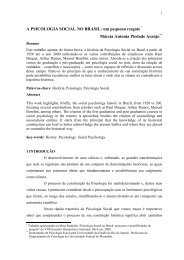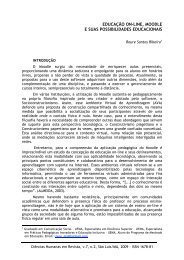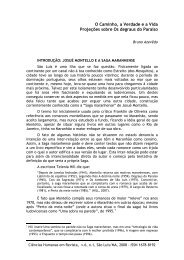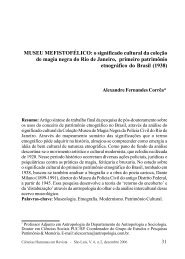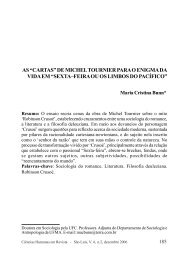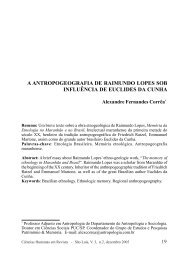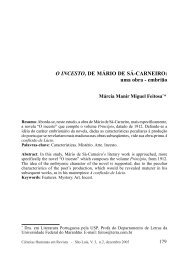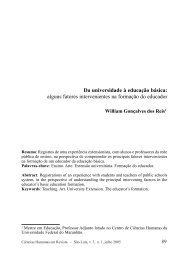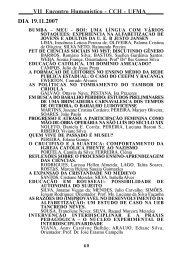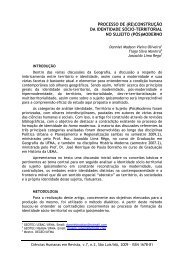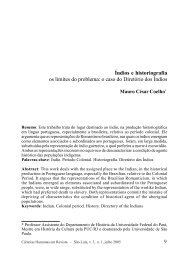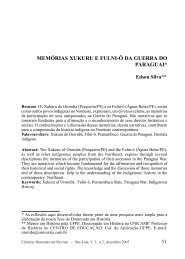Transformando corpos em pergaminhos - Nucleo de Humanidades ...
Transformando corpos em pergaminhos - Nucleo de Humanidades ...
Transformando corpos em pergaminhos - Nucleo de Humanidades ...
Create successful ePaper yourself
Turn your PDF publications into a flip-book with our unique Google optimized e-Paper software.
Emilene Leite <strong>de</strong> Sousa<br />
As inscrições no corpo - que transformam cada vez mais, na<br />
socieda<strong>de</strong> atual, <strong>corpos</strong> <strong>em</strong> <strong>pergaminhos</strong> – transformam o sujeito <strong>em</strong><br />
objeto <strong>de</strong> exposição por todo o t<strong>em</strong>po <strong>de</strong> vida do indivíduo e <strong>em</strong> todo e<br />
qualquer espaço por on<strong>de</strong> ele transite.<br />
Assim, a cont<strong>em</strong>poraneida<strong>de</strong> é caracterizada pela arte que transita<br />
sobre os <strong>corpos</strong> dos indivíduos mo<strong>de</strong>rnos, cuja i<strong>de</strong>ntida<strong>de</strong> circunstancial,<br />
efêmera, não-fixa, só encontra como referência estável, lugar <strong>de</strong><br />
ancorag<strong>em</strong> no mundo social, o próprio corpo transformado <strong>em</strong> mosaico,<br />
pergaminho, colcha <strong>de</strong> retalhos pela atuação do indivíduo <strong>de</strong> resignificar<br />
o que está dado, transformando a natureza com as marcas<br />
da cultura, exercendo o seu papel <strong>de</strong> bricoleur do social.<br />
TRANSFORMING BODIES INTO PARCHMENT.<br />
Abstract: Society has always used the body to inscribe its rules, its laws,<br />
placing it un<strong>de</strong>r the law of a culture. The body of the post-mo<strong>de</strong>rn man<br />
turns into parchment where he and society write a text. On it relies the<br />
inscription of everyday events and processes of i<strong>de</strong>ntification of our subjects<br />
carrying increasingly polyphonic bodies. Therefore, the importance of<br />
thinking i<strong>de</strong>ntity of groups or individuals from the tattoo which operates as<br />
a <strong>de</strong>vice for i<strong>de</strong>ntifying both individual and collective. However, if the<br />
construction of i<strong>de</strong>ntity takes as reference the body, how to think the body<br />
and the use one can make of it in post-mo<strong>de</strong>rnity? How to think about a<br />
not-fixing i<strong>de</strong>ntify, circumstantial, disposable, fragmented, attached to a<br />
body which r<strong>em</strong>ains one, undivi<strong>de</strong>d, fixed? The cont<strong>em</strong>porary nature is<br />
characterized by the art which is shown on the bodies of the individuals,<br />
whose circumstantial, not-fixed i<strong>de</strong>ntity find as stable reference, a place of<br />
anchoring in the social world, the own body transformed into mosaic or<br />
parchment by the performance of the individual to re-mean what is given<br />
by exercising his role as social bricoleur.<br />
Keywords: Body. I<strong>de</strong>ntification. Tattooing.<br />
CONVIRTIENDO CUERPOS EN PERGAMINOS<br />
Resumen: La sociedad si<strong>em</strong>pre se utilizó <strong>de</strong>l cuerpo para inscribir sus reglas,<br />
sus leyes colocándolo bajo la ley <strong>de</strong> una cultura. El cuerpo <strong>de</strong>l hombre<br />
postmo<strong>de</strong>rno se convierte en pergamino don<strong>de</strong> él y la sociedad inscriben<br />
um texto. En él resi<strong>de</strong> la inscripción <strong>de</strong> los eventos diarios y <strong>de</strong> los procesos<br />
<strong>de</strong> i<strong>de</strong>ntificación <strong>de</strong> nuestros sujetos portadores <strong>de</strong> cuerpos cada vez más<br />
polifónico. Por eso, la importancia <strong>de</strong> pensar la i<strong>de</strong>ntidad <strong>de</strong> grupos <strong>de</strong><br />
individuos <strong>de</strong>s<strong>de</strong> el tatuaje que opera como dispositivo <strong>de</strong> i<strong>de</strong>ntificación<br />
tanto individual cuanto colectiva. Ora, si la construcción <strong>de</strong> la i<strong>de</strong>ntidad<br />
toma como referencia el cuerpo, ¿cómo pensar el cuerpo y el uso que<br />
hac<strong>em</strong>os <strong>de</strong> él en la postmo<strong>de</strong>rnidad? ¿Cómo pensar una i<strong>de</strong>ntidad no<br />
fijada, circunstancial, <strong>de</strong>sechable, fragmentada, arrestada a un cuerpo que<br />
68 Ciências Humanas <strong>em</strong> Revista - São Luís, V.5, n.2, <strong>de</strong>z<strong>em</strong>bro 2007



